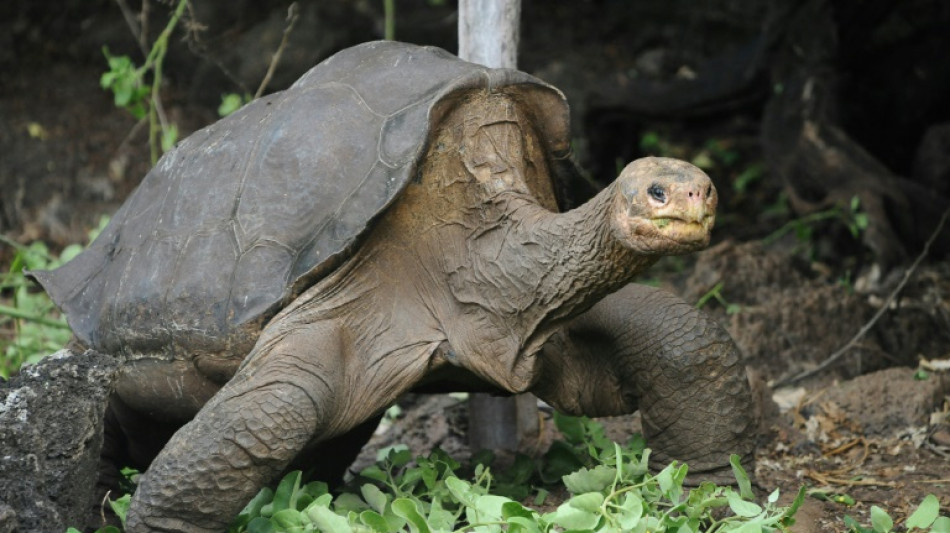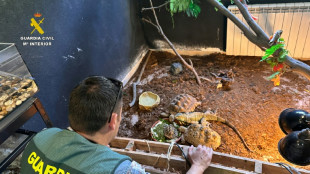
-
 Japa's Miura and Kihara capture Skate America pairs gold
Japa's Miura and Kihara capture Skate America pairs gold
-
Who can qualify for 2026 World Cup in final round of European qualifiers

-
 UK to cut protections for refugees under asylum 'overhaul'
UK to cut protections for refugees under asylum 'overhaul'
-
England's Tuchel plays down records before final World Cup qualifier

-
 Depoortere double helps France hold off spirited Fiji
Depoortere double helps France hold off spirited Fiji
-
Scotland face World Cup shootout against Denmark after Greece defeat

-
 Hansen hat-trick inspires Irish to record win over Australia
Hansen hat-trick inspires Irish to record win over Australia
-
Alcaraz secures ATP Finals showdown with 'favourite' Sinner

-
 UK to cut protections for refugees under asylum 'overhaul': govt
UK to cut protections for refugees under asylum 'overhaul': govt
-
Spain, Switzerland on World Cup brink as Belgium also made to wait

-
 Sweden's Grant leads by one at LPGA Annika tournament
Sweden's Grant leads by one at LPGA Annika tournament
-
Scotland cling to hopes of automatic World Cup qualification despite Greece defeat

-
 Alcaraz secures ATP Finals showdown with great rival Sinner
Alcaraz secures ATP Finals showdown with great rival Sinner
-
England captain Itoje savours 'special' New Zealand win

-
 Wales's Evans denies Japan historic win with last-gasp penalty
Wales's Evans denies Japan historic win with last-gasp penalty
-
Zelensky renews calls for more air defence after deadly strike on Kyiv

-
 NBA's struggling Pelicans sack coach Willie Green
NBA's struggling Pelicans sack coach Willie Green
-
Petain tribute comments raise 'revisionist' storm in France

-
 Spain on World Cup brink as Belgium also made to wait
Spain on World Cup brink as Belgium also made to wait
-
Spain virtually seal World Cup qualification in Georgia romp

-
 M23, DR Congo sign new peace roadmap in Doha
M23, DR Congo sign new peace roadmap in Doha
-
Estevao, Casemiro on target for Brazil in Senegal win

-
 Ford steers England to rare win over New Zealand
Ford steers England to rare win over New Zealand
-
Massive march in Brazil marks first big UN climate protest in years

-
 Spain rescues hundreds of exotic animals from unlicensed shelter
Spain rescues hundreds of exotic animals from unlicensed shelter
-
Huge fire sparked by explosions near Argentine capital 'contained'

-
 South Africa defy early red card to beat battling Italy
South Africa defy early red card to beat battling Italy
-
Sinner beats De Minaur to reach ATP Finals title match

-
 Zelensky vows overhaul of Ukraine's scandal-hit energy firms
Zelensky vows overhaul of Ukraine's scandal-hit energy firms
-
South Africa defy early red card to beat Italy

-
 Alex Marquez claims Valencia MotoGP sprint victory
Alex Marquez claims Valencia MotoGP sprint victory
-
McIlroy shares lead with Race to Dubai title in sight

-
 Climate protesters rally in Brazil at COP30 halfway mark
Climate protesters rally in Brazil at COP30 halfway mark
-
Spike Lee gifts pope Knicks jersey as pontiff meets film stars

-
 BBC caught in crossfire of polarised political and media landscape
BBC caught in crossfire of polarised political and media landscape
-
'Happy' Shiffrin dominates in Levi slalom for 102nd World Cup win

-
 Palestinian national team on 'mission' for peace in Spain visit
Palestinian national team on 'mission' for peace in Spain visit
-
Brazilian 'Superman' cheers child cancer patients in Ghana

-
 India close in on win over South Africa after Jadeja heroics
India close in on win over South Africa after Jadeja heroics
-
Huge explosions rock industrial area near Argentina's capital

-
 Bezzecchi takes pole for Valencia sprint and MotoGP
Bezzecchi takes pole for Valencia sprint and MotoGP
-
Dominant Shiffrin leads after first slalom run in Levi

-
 Nine killed in accidental explosion at Indian Kashmir police station
Nine killed in accidental explosion at Indian Kashmir police station
-
Climate protesters to rally at COP30's halfway mark

-
 Fighting South Africa lose Rickelton after India 189 all out
Fighting South Africa lose Rickelton after India 189 all out
-
Harmer leads South Africa fightback as India 189 all out

-
 Prison looms for Brazil's Bolsonaro after court rejects his appeal
Prison looms for Brazil's Bolsonaro after court rejects his appeal
-
EU bows to pressure on loosening AI, privacy rules

-
 India close in on lead despite South African strikes
India close in on lead despite South African strikes
-
Curry's 49 points propel Warriors in 109-108 win over Spurs


Extinct-in-the-wild species in conservation limbo
For species classified as "extinct in the wild", the zoos and botanical gardens where their fates hang by a thread are as often anterooms to oblivion as gateways to recovery, new research has shown.
Re-wilding what are often single-digit populations faces the same challenges that pushed these species to the cusp of extinction in the first place, including a lack of genetic diversity. But without conservation efforts, experts say, chances of these species surviving would be even smaller.
Since 1950, nearly 100 animal and plant species vanquished from nature by hunting, pollution, deforestation, invasive lifeforms and other drivers of extinction have been put into critical care by scientists and conservationists, according to the findings.
While the category "extinct in the wild" was not added to the benchmark Red List of Threatened Species until 1994, the term could have applied to all of them.
Of these species teetering on the edge, 12 have been reintroduced to some degree back into the wild, according to a pair of studies published last week in the journals Science and Diversity.
Another 11, however, have gone the way of dinos, dodos and dozens of Pacific island trees, whose delicate flowers will never again grace the planet.
Biodiversity loss has reached crisis proportions not seen since an errant asteroid as big across as Paris smashed into Earth 66 million years ago, wiping out land dinosaurs and ending the Cretaceous period.
That was one of five so-called mass extinction events over the last half-billion years.
Scientists say human activity has pushed Earth into the sixth, with species disappearing 100 to 1,000 times more quickly than normal.
"Real opportunities to prevent extinction and return previously lost species to the wild abound and we must take them," the international team of 15 authors said.
"We have lost 11 species entirely under our care to extinction since 1950."
- Success stories -
Another study published last week in Current Biology -- looking at the "Great Dying" event 252 million years ago that annihilated 95 percent of life on Earth -- showed that accelerated species loss preceded broader ecological collapse.
"Currently, we may be losing species at a faster rate than in any of Earth's past extinctions," lead author Yuangeng Huang, a researcher at the China University of Geosciences, told AFP.
"We cannot predict the tipping point that will send ecosystems into a total collapse but it is an inevitable outcome if we do not reverse biodiversity loss."
Recent conservation success stories -- some of them heroic -- include the European bison, which once roamed across Europe.
By the 1920s their numbers were so reduced that surviving specimens were rounded up into zoos and a breeding programme was launched in Poland.
After reintroduction into the wild in 1952, the broad-shouldered beasts thrived and are no longer considered threatened with extinction by the Internation Union for the Conservation of Nature (IUCN), the keepers of the Red List.
Red wolves in North America, wild horses in central Asia and the desert-dwelling Arabian oryx have all staged comebacks with a helping human hand.
So has the largest land tortoise in the world, native to Espanola Island in the Galapagos.
By the 1970s, Chelonoidis hoodensis had been eaten to the brink. Fourteen surviving individuals were removed and relocated decades later to another island, where their numbers are increasing.
- 'Overlooked category' -
Giant Pinta tortoises on a neighbouring Galapagos island -- one of the 11 extinct-in-the-wild species that didn't make it -- were not so lucky.
After living for half a century as his species' sole survivor, a 75-kilogramme (165-pound) male known as Lonesome George died in 2012.
Other creatures that never made it out of intensive care include Hawaii's black-faced honey creeper, a petite bird devastated by mosquito-borne avian malaria last seen in 2004; Mexico's freshwater Catarina pupfish, unsuccessfully relocated to captivity when its native habitat dried out due to groundwater extraction; and five types of snail on the Society Islands that fell victim to an invasive carnivorous cousin.
Surprisingly, the studies show that species surviving only in controlled environments are in a kind of conservation limbo.
"This is an overlooked category," the researchers noted.
"Despite being considered most at risk, extinct-in-the-wild species are not assessed under the Red List process."
"We have largely ignored the extent of, and the variation in, extinction risk of the very group of species for which humans are most responsible," they added.
Of the 84 species currently with this status, nearly half have not benefitted from attempts to reintroduce them into the wild. Most are plants, suggesting a possible bias towards reintroducing animals that might not be entirely scientifically justified.
At its most recent World Conservation Congress in 2020, the IUCN called for the reestablishment of extinct-in-the-wild species in the wild by 2030.
V.Said--SF-PST

